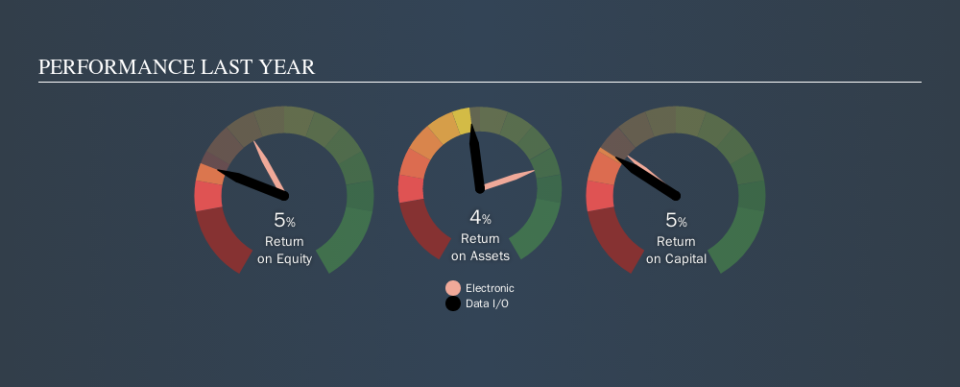Examining Data I/O Corporation’s (NASDAQ:DAIO) Weak Return On Capital Employed

Today we'll look at Data I/O Corporation (NASDAQ:DAIO) and reflect on its potential as an investment. Specifically, we'll consider its Return On Capital Employed (ROCE), since that will give us an insight into how efficiently the business can generate profits from the capital it requires.
First, we'll go over how we calculate ROCE. Second, we'll look at its ROCE compared to similar companies. Last but not least, we'll look at what impact its current liabilities have on its ROCE.
What is Return On Capital Employed (ROCE)?
ROCE is a measure of a company's yearly pre-tax profit (its return), relative to the capital employed in the business. All else being equal, a better business will have a higher ROCE. In brief, it is a useful tool, but it is not without drawbacks. Renowned investment researcher Michael Mauboussin has suggested that a high ROCE can indicate that 'one dollar invested in the company generates value of more than one dollar'.
So, How Do We Calculate ROCE?
The formula for calculating the return on capital employed is:
Return on Capital Employed = Earnings Before Interest and Tax (EBIT) ÷ (Total Assets - Current Liabilities)
Or for Data I/O:
0.051 = US$1.3m ÷ (US$30m - US$5.3m) (Based on the trailing twelve months to June 2019.)
Therefore, Data I/O has an ROCE of 5.1%.
Check out our latest analysis for Data I/O
Is Data I/O's ROCE Good?
ROCE is commonly used for comparing the performance of similar businesses. Using our data, Data I/O's ROCE appears to be significantly below the 12% average in the Electronic industry. This performance is not ideal, as it suggests the company may not be deploying its capital as effectively as some competitors. Independently of how Data I/O compares to its industry, its ROCE in absolute terms is low; especially compared to the ~2.7% available in government bonds. There are potentially more appealing investments elsewhere.
You can see in the image below how Data I/O's ROCE compares to its industry. Click to see more on past growth.
It is important to remember that ROCE shows past performance, and is not necessarily predictive. ROCE can be misleading for companies in cyclical industries, with returns looking impressive during the boom times, but very weak during the busts. This is because ROCE only looks at one year, instead of considering returns across a whole cycle. What happens in the future is pretty important for investors, so we have prepared a free report on analyst forecasts for Data I/O.
Do Data I/O's Current Liabilities Skew Its ROCE?
Short term (or current) liabilities, are things like supplier invoices, overdrafts, or tax bills that need to be paid within 12 months. Due to the way the ROCE equation works, having large bills due in the near term can make it look as though a company has less capital employed, and thus a higher ROCE than usual. To counter this, investors can check if a company has high current liabilities relative to total assets.
Data I/O has total liabilities of US$5.3m and total assets of US$30m. Therefore its current liabilities are equivalent to approximately 18% of its total assets. This is not a high level of current liabilities, which would not boost the ROCE by much.
Our Take On Data I/O's ROCE
That's not a bad thing, however Data I/O has a weak ROCE and may not be an attractive investment. Of course, you might also be able to find a better stock than Data I/O. So you may wish to see this free collection of other companies that have grown earnings strongly.
If you like to buy stocks alongside management, then you might just love this free list of companies. (Hint: insiders have been buying them).
We aim to bring you long-term focused research analysis driven by fundamental data. Note that our analysis may not factor in the latest price-sensitive company announcements or qualitative material.
If you spot an error that warrants correction, please contact the editor at editorial-team@simplywallst.com. This article by Simply Wall St is general in nature. It does not constitute a recommendation to buy or sell any stock, and does not take account of your objectives, or your financial situation. Simply Wall St has no position in the stocks mentioned. Thank you for reading.

